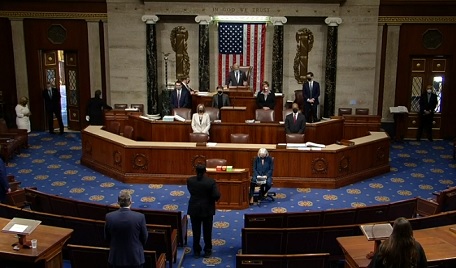The House of Representatives adopted an article of impeachment against President Donald J. Trump on Wednesday, setting in motion a Senate trial to consider the president’s removal from office and his disqualification from future federal office.
 The full House voted 232-197 to approve the impeachment charge, setting the stage for a likely trial in the Senate under Article I, Section 3. The article alleged President Trump incited “violence against the Government of the United States” in relation to a riot at the U.S. Capitol on January 6 as Congress met in joint session to certify the Electoral College results of the 2020 election. The charge also claimed Trump tried to “subvert and obstruct the certification of the results of the 2020 Presidential election” in a call with Georgia’s secretary of state.
The full House voted 232-197 to approve the impeachment charge, setting the stage for a likely trial in the Senate under Article I, Section 3. The article alleged President Trump incited “violence against the Government of the United States” in relation to a riot at the U.S. Capitol on January 6 as Congress met in joint session to certify the Electoral College results of the 2020 election. The charge also claimed Trump tried to “subvert and obstruct the certification of the results of the 2020 Presidential election” in a call with Georgia’s secretary of state.
As of Wednesday afternoon, it seemed likely the Senate trial would start after President Trump leaves office, based on reported comments from current Majority Leader Mitch McConnell. If so, the trial would focus on Trump’s “disqualification to hold and enjoy any office of honor, trust, or profit under the United States.”
Trump becomes the first president to face two separate Senate trials on impeachment charges presented by the House. In December 2019, the House presented two articles of impeachment to the Senate: one charging that President Trump “abused the powers of the Presidency” by soliciting the interference of the government of Ukraine in the upcoming presidential election, and the second charging obstruction of Congress by refusing to cooperate with the House's impeachment inquiry. In February 2020, the Senate acquitted Trump on both charges.
Rep. David N. Cicilline of Rhode Island introduced a resolution accusing President Trump of committing “high Crime and Misdemeanors,” one of the bases for impeachment and removal set by Article II, Section 4 of the Constitution.
After Wednesday’s voting, the House will appoint the “impeachment managers,” typically members of the House, who will prosecute the case in the Senate. Once impeachment managers are chosen, the House will pass and transmit to the Senate a separate resolution formally stating the impeachment charges and the names of the trial managers. The Senate then will notify the House impeachment managers of the starting date of Senate proceedings.
Under Article I, Section 3 of the Constitution, the Senate has the sole power to conduct impeachment trials. Normally as the defendant, in this case, is the president, the Chief Justice of the United States, John Roberts, would preside over the trial. But if Trump is tried in the Senate after he leaves office, it is not yet known if Chief Justice Roberts would preside over the trial as a president has never faced an impeachment trial after leaving office before.
Because of this, Trump’s defense team might argue that as a former federal civil officer, Trump would not be subject to a Senate trial after leaving office. Similar arguments were made in prior impeachment trials of other federal officials, including Senator William Blount in 1799. However, if the trial does proceed, standing rules first adopted for President Andrew Johnson’s impeachment trial in 1868 (and updated several times since then) will be used to conduct the trial.
On the proceeding’s first day, the House managers appear in the Senate and formally present the impeachment articles to be tried. The Senate will issue a writ of summons asking Trump or his counsel to appear before it and will also set a trial date. The Senate then forms itself as a court of impeachment, with Senators taking a special oath to “do impartial justice.”
The trial will proceed as the House managers and defense counsel argue their cases, and witnesses are called to testify. The presiding officer will rule on questions about evidence and procedure, subject to being overruled by a majority vote of the whole Senate.
The Senate will then meet in a closed session to vote on the charges. Per Article I, Section 3, a two-thirds supermajority of the senators present (or 67 out of 100 senators) must vote to convict Trump on an article of impeachment.
Resources from the National Constitution Center
Can President Trump be impeached after he leaves office?
The House's Impeachment Powers







